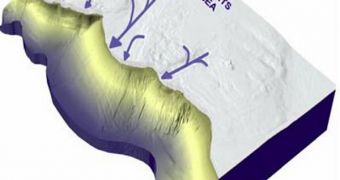A group of investigators has recently determined that a strong connection exists between the fast-flowing ice streams on which ice sheets move and climate change. When ice caps are displaced during ice ages, they move on top of these rapidly-moving structures, which carve out distinct patterns in the ocean floor. Researchers do not say that, by analyzing these markings, they can gain more insight into the nature of the climate conditions that existed on our planet when the events actually took place.
A research paper detailing the possible correlation between the two phenomena has just been published in the latest issue of the esteemed scientific journal International Innovation. The magazine dedicates this edition ground-breaking international research into global warming and climate change, and also features interesting interviews with leading scientists in the field.
The new investigation, called “Stemming the flow of climate change,” is authored by the University of Barcelona Department of Stratigraphy, Paleontology and Marine Geosciences ICREA research professor Angelo Camerlenghi, who collaborated closely with colleague Michele Rebesco, from the National Institute of Oceanography and Geophysics, in Trieste, AlphaGalileo reports.
The investigators say that ice streams tend to carve up characteristic paths in the ocean floor, but add that the process takes place gradually, over several thousands of years. They basically represent the pathways ice flowing from inside the continent drains into the ocean, and the scars of this process are clearly visible if you know where to look for them. The two main purposes of studying these formations are understanding ocean-climate interactions in more depth and assessing the stability of large ice masses over prolonged periods of time, the researchers say.
“Studying the ice streams of the past is fundamental in understanding present-day ice dynamics and their link to climate change,” explains Marine Geosciences Research Group member Dr. Angelo Camerlenghi. He is also the coordinator of the Neogene Ice-Streams and Sedimentary Processes on High-Latitude Continental Margins (NICE-STREAMS) initiative, which is the project under which the new study was conducted, as part of the International Polar Year (IPY) Directive.
“Geological reconstructions of natural change in the past show clearly that our climate is changing more rapidly than ever. Model predictions tend to be contradicted by observations, which have shown in recent years that the response is much faster than suggested by the simulations. Our studies of the recent past will hopefully provide the ideal data for improving predictive models,” the scientist adds.

 14 DAY TRIAL //
14 DAY TRIAL //